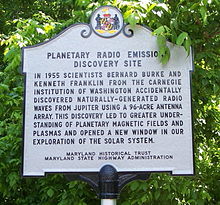Kenneth Franklin
Kenneth L. Franklin | |
|---|---|
Hayden Planetarium, Jupiter | |
| Scientific career | |
| Fields | astronomy |
| Thesis | A spectrophotometric investigation of Capella (1953) |
Kenneth Linn Franklin (March 25, 1923 – June 18, 2007) was an American
Early life and discovery

Franklin was born in
Career
After the notable discovery of 1955, Franklin was frequently invited as an astronomical expert on television and radio. He appeared on a
An
Franklin lived in Loveland, Colorado until his death in Boulder from heart surgery complications. He was survived by his wife, three daughters, six grandchildren, and six great-grandchildren.[2]
He was a member of the all-male literary banqueting club the Trap Door Spiders, which served as the basis of Isaac Asimov's fictional group of mystery solvers the Black Widowers. He was a lifelong friend of Asimov's, & they took several ocean solar eclipse cruises together. After he retired, he & his wife, Charlotte, whom he met at Carnegie where she also worked, traveled the Americas via Airstream.
References
- ^ Carnegie Institution of Washington Department of Terrestrial Magnetism web site. Archived December 7, 2006, at the Wayback Machine
- ^ a b c d Kenneth Franklin, Astronomer, Dies at 84 — Obituary from The New York Times by Douglas Martin, June 21, 2007.
- Times Online, June 28, 2007.
